About
As an intercultural gathering place, the Gordon Oakes Red Bear Student Centre brings together the teachings, traditions and cultures of the peoples of Saskatchewan. G rounded in the teachings of collaboration, cooperation, humility, reciprocity and sharing, the centre aims to enhance First Nations, Métis and Inuit student success.
The centre's purpose is to facilitate the coordination of effective student services for Métis, First Nations and Inuit students and build relationships within and outside the university with Indigenous peoples. The centre provides a home for Indigenous undergraduate and graduate student leadership and allows for mutual learning opportunities for students and faculty. The centre also functions as the university’s hub for on-campus Indigenous engagement and initiatives.
The Office of Indigenous Engagement oversees the Gordon Oakes Red Bear Student Centre. and helps the university community achieve its goals in Indigenous engagement. Through collaboration and relationship building, we seek to create a welcoming university environment that is grounded in the teachings of collaboration, reconciliation, reciprocity and meaningful change.
The Gordon Oakes Red Bear Student Centre prides itself on creating an inclusive community on campus. The centre offers personal, social, cultural and academic support to Métis, First Nations and Inuit students through a variety of programs, services and special events throughout the year.
The Building and Virtual Tour
Design
The design of the Gordon Oakes Red Bear Student Centre was envisioned by Douglas Cardinal and RBM Architects. Cardinal is an internationally renowned architect of Métis and Blackfoot heritage and is a forerunner in philosophies of sustainability, green buildings and ecological design in community planning.
Cardinal’s architecture is inspired by his observations of nature and grounded within his cultural beliefs. Other examples of Cardinal’s work include the Canadian Museum of Civilization in Hull, Quebec; First Nations University of Canada in Regina, Saskatchewan; and the National Museum of the American Indian in Washington, D.C.
Exterior
The design of the centre is rich with cultural significance. The exterior of the building is composed of Tyndall stone that adorns many other buildings on campus. The stone wraps around the building creating a symbolic blanket to protect the building's centre from the harsh Prairie winds.
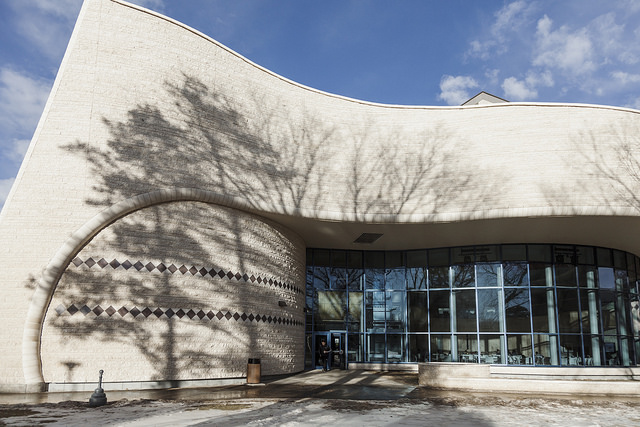
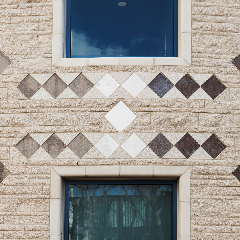
Tiles
Two rows of inlayed tile that encircle the building represent a wampum belt, which is symbolic of treaties between Indigenous peoples and newcomers on the land that would later become Canada. At each of the four cardinal directions, the colour of the tiles changes to represent each of the four seasons: south (summer, red), east (spring, yellow), west (autumn, charcoal), and north (winter, white).

Ceiling
The ceiling is decorated as a medicine wheel using colours chosen by the Oakes family to protect those inside the building.
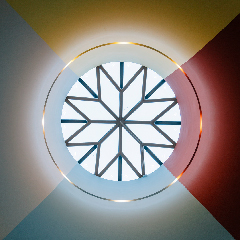
Feature Skylight
The feature skylight is inspired by the design of a star blanket.
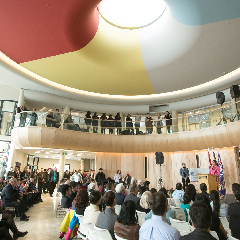
Central Gathering
The central gathering area can be used for ceremonial smudging and pipe ceremonies. A large exhaust fan is hidden within the high ceiling, and the fan's exterior vents are aligned with the four cardinal directions. Being connected to the earth is important during ceremony, so soil was taken from the building's excavation and was placed within a large concrete cylinder in the basement of the building, connecting the gathering space to the ground beneath.
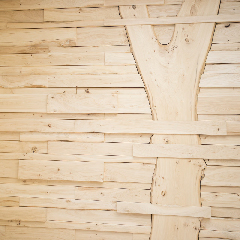
Entrance
The entrace to the building features a wall composed of elm wood recovered from trees removed from the building's construction site.

Second Floor
The second floor of the building has study space, a kitchenette, a computer lab and office space for the Indigenous Students' Council, the Indigenous Graduate Students' Council and tutors.
Gordon Oakes Red Bear (The Man)
Gordon Oakes Red Bear was a spiritual and community leader who guided many in his community and across Saskatchewan. He was born in 1932 in what is now the Nekaneet First Nation and passed away in early 2002.
Oakes believed in Indigenous and non-Indigenous peoples working together for each other’s mutual benefit, using the analogy of a team of horses pulling together and living in balance to impart this teaching. Because he held a strong belief in education and honouring one’s culture and traditions, this building is named in his memory.
Gordon Oakes Red Bear served as the Chief of the Nekaneet First Nation from 1958 to 1962 and again from 1970 to 1992. Throughout this time he worked passionately for Treaty Land Entitlement until it was finally adopted by the province. Oakes also sat at the Treaty Tables within the Treaty Governance Processes of the Federation of Saskatchewan Indian Nations. In all of this work, he helped shape the understanding of the treaty relationship as it exists in Saskatchewan.
As an Elder, Gordon Oakes served as a board member of the Wanuskewin Heritage Park. Through his work he also helped bring to fruition the eventual placement of the Okimaw Ohci Healing Lodge in the Cypress Hills. He created the Treaty 4 flag, which is now used by Treaty 4 First Nations as a symbol of connectedness.


